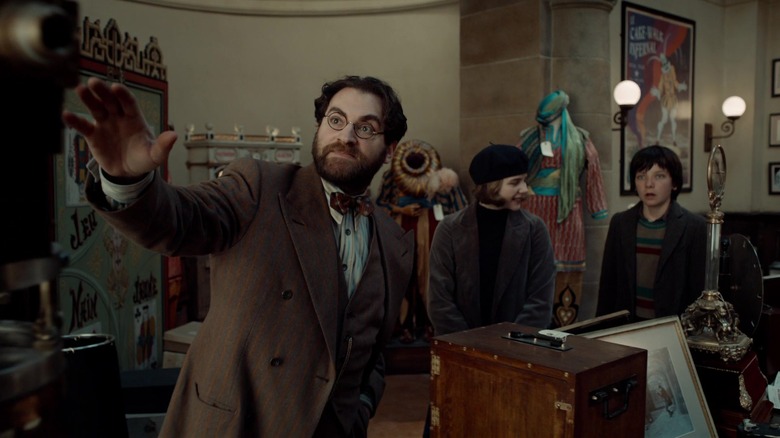James Cameron's Favorite Use Of 3D In A Movie May Surprise You
We may receive a commission on purchases made from links.
It's clear that when it comes to 3D photography in cinema, James Cameron is the primary pioneer of the medium. Following the landmark success of his 1997 blockbuster "Titanic," Cameron began developing his passion project, "Avatar." He wound up taking more than a decade to craft, film, and complete his sci-fi epic primarily due to the rate at which technology was changing in order to match with his ambitious vision of Pandora, the home of the Na'vi. When filming "Avatar," Cameron and cinematographer Vince Pace even developed the Fusion Camera System, which is a digital camera system used to shoot films in stereoscopic 3D. It utilized two high-definition cameras in a single camera body to capture depth perception.
12 years after audiences around the world flocked cinemas in record-breaking numbers to witness Cameron's epic recreation of one of the most notable disasters of the 20th century, they came in droves once again for his newest technological marvel. "Avatar" would eventually go on to become the highest-grossing film of all-time, topping his "Titanic." Although the film remains a heavily-contested topic amongst cinephiles in regards to its cliched storytelling (which borrows heavily from films like "FernGully: The Last Rainforest" and "Dances with Wolves"), the sheer spectacle of witnessing the visual splendor of Pandora in what was, at the time, the most immersive use of 3D solidifies "Avatar" as one of the most viscerally enthralling cinematic experiences ever.
Cameron remains the undisputed king of 3D cinema, and in the wake of the success of "Avatar," every studio jumped aboard the bandwagon hoping for a taste of that glorious 3D ticket price-inflated box office. Unfortunately, most releases were 3D post-conversion jobs, and for every "How to Train Your Dragon," which showcased some of the greatest use of 3D ever, you had a "Clash of the Titans" or, worse, "The Last Airbender," which bastardized the tech, causing audiences to lose interest. Indeed, rather than following Cameron's lead in using 3D to enhance the viewing experience, most studios instead opted to employ it as a gimmick that added little to the finished product. However, there was one film so notable for its 3D cinematography that Cameron considered it the greatest use of the technology he had ever seen.
James Cameron recognizes Martin Scorsese's Hugo as the greatest use of 3D
In 2011, Paramount Pictures released "Hugo," as directed by Academy Award-winner Martin Scorsese. The film, itself based on the novel "The Invention of Hugo Cabret" by writer/illustrator Brian Selznick, was a major departure for Scorsese — not only due to the fact that it is still the only film in his filmography you can comfortably watch with your family, but also because it was his first (and so far, only) foray into 3D photography. Although the movie underperformed at the box office, grossing $185.8 million on a budget in the range of $150-170 million, it was subject to massive acclaim, receiving 11 Academy Award nominations and winning five, including the Oscar for Best Cinematography. But perhaps the most glowing acclaim for "Hugo" came from none other than James Cameron.
Following a screening of "Hugo" at the Directors Guild of America theater in Los Angeles, Cameron and Scorsese sat together to lead a discussion of the film, particularly its effective use of 3D. From one master filmmaker to another, Cameron showered Scorsese with his greatest endorsement (per The Hollywood Reporter):
"It doesn't serve the film to talk about the 3D as if it's a separate thing. I mean, of course it's a lead story that a filmmaker of Marty's stature and pedigree is working in 3D. Because it's sort of breaking down this idea that 3D is for just hyper-commercial films. What you did was you integrated it with the color, with the composition, with the camera movement, with the acting. Everything. I would say it's like a 16-cylinder Bugatti firing perfectly on every cylinder. It's absolutely the best 3D photography that I've seen. It's constantly supportive of what you're doing artistically and never detractive."
3D is meant to be a tool, not a gimmick
Cameron's praise of Scorsese's use of 3D with "Hugo" is especially notable since the latter is not an action film, which the technology is usually associated with. Rather, 3D is a tool used to dive deeper into the characters and story. For those who had the opportunity to see "Hugo" in its initial theatrical release, the 3D imagery was not only staggering in its depth-of-field, camera movement, and color composition, but it was also integral to the film's narrative. While "Hugo" is fictional, it draws heavily from the life of French filmmaker Georges Méliès, as portrayed in the film by Ben Kingsley (who was woefully robbed of an Oscar nod for his performance). Scorsese touched upon why 3D was integral to the film, with Cameron adding that it was woven into the movie in a meta fashion:
Scorsese: "The big stigma is the fashion to say it's a gimmick. You gotta understand, when moving images first started, people wanted sound, color, big screen, and depth. The Lumiere films, two of them are in 3D. And Melies was already going there."
Cameron: "Your film is about the very first days of the magic of cinema. And in its execution, the medium is the message. The movie is magical to watch. So, you've exactly closed the ellipse in such an amazing, artistic way."
Despite its five Academy Award wins, "Hugo" remains an underrated film within Scorsese's celebrated career. Given that he has gifted us some of the greatest films of all-time, with many of them exploring less family-friendly material, it is understandable why the warm, whimsy of "Hugo" might be overshadowed in favor of the darker, grimier "Taxi Driver" and "Goodfellas." Funny enough, Scorsese followed "Hugo" up with "The Wolf of Wall Street," which is arguably his most family-unfriendly film ever. Despite sticking out like a sore thumb in his filmography, "Hugo" is still worth watching for its meticulous craftsmanship.
Obviously, the best way to experience "Hugo" is in 3D, which can still be seen at home through its stunning transfer on 3D Blu-ray (which you can purchase here). Although 3D TV's are out of fashion these days, those who still have one have the best chance at viewing the film the way Scorsese intended. Of course, should the opportunity arise in which the film is screening in 3D at a theater near you, it is worth actively seeking out. It's rare a film demands to be viewed in this format, let alone one of this genre, but "Hugo" honestly requires it. After all, if James Cameron's ringing endorsement isn't enough to sway you, then nothing will.


